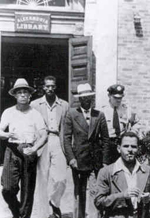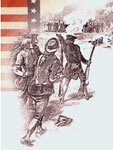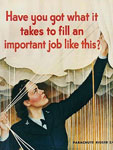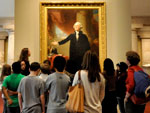What first comes to mind when you hear the phrase "primary sources?" Famous documents such as the Declaration of Independence? Newspaper articles reporting on Pearl Harbor? Letters from soldiers during the Civil War? Maybe you think of visual sources—antique maps or Lewis Hine photographs.
But what about artwork? What does a 1796 portrait of George Washington tell us—about the man, about the time, about the artist? What does an 1851 painting of Washington crossing the Delaware say? It can't be a primary source for the actual crossing, but what information does it convey about American mythology and historical understanding? What information can students bring away from a piece of art?
Like all primary sources, artwork offers unique opportunities and pitfalls when introduced to the classroom. Carolyn Halpin-Healy, of the Metropolitan Museum of Art, suggests seven steps students (and their teachers) should take when approaching art. After processing their initial emotional reactions and describing what they see, students move on to considering the art's original context and historical connections. They then reassess the piece using their new, fuller understanding.
For a sense of this process—though not a full exploration—watch professor David Jaffee analyze two 19th-century artworks, a family portrait and a popular print.

Interested in trying out this approach for yourself? For a ready-to-run lesson, EDSITEment's "Midnight Ride of Paul Revere: Fact, Fiction, and Artistic License" guides high school students in interpreting a 1931 painting of Paul Revere's ride.
If you have the time and resources for a field trip, search Teachinghistory.org's Historic Sites and Museums database for museums where students can examine art in person. Also consider contacting local museums about professional development opportunities—they may offer pre-trip orientations for teachers or workshops focusing on teaching with art.
If you can't take your students to the art, bring the art to them. The Internet hosts a wealth of virtual collections from museums across the country (and the world). Wherever you live, your students can draw on the resources of the
National Portrait Gallery or the Smithsonian American Art Museum. A keyword search for "art" in Teachinghistory.org's Website Reviews brings up more than 150 archives and exhibits, free to access online.
And for suggestions of even more resources, see how our co-director, Daisy Martin, answers the question, "What resources or techniques would you recommend for teaching using art and its analysis in the social studies/U.S. history classroom?" in Ask a Master Teacher.





